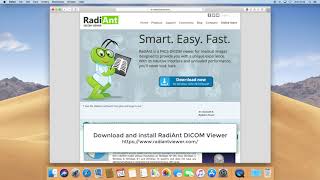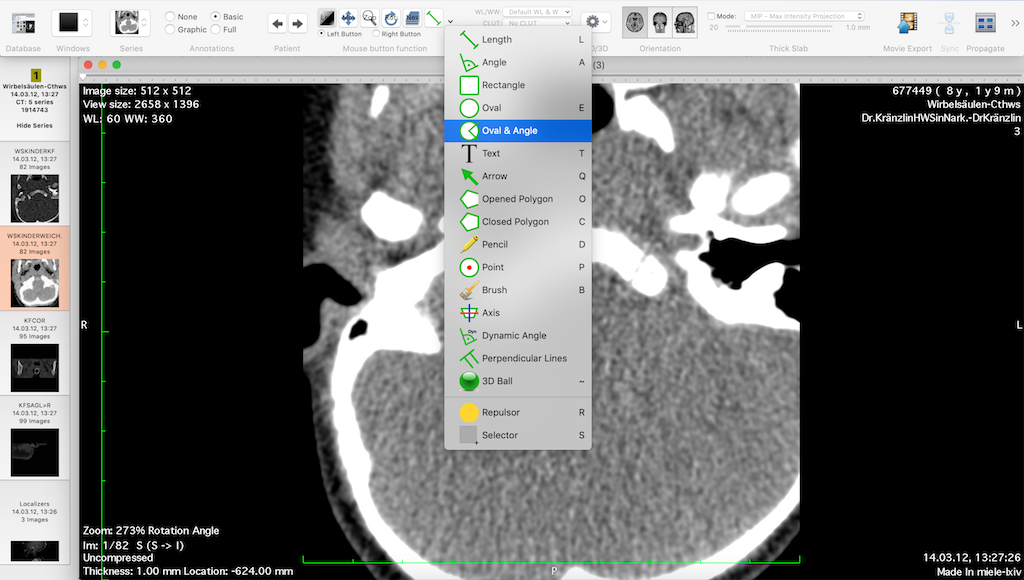

- #PROGRAM FOR MAC DICOM READER MAC OS X#
- #PROGRAM FOR MAC DICOM READER SERIES#
- #PROGRAM FOR MAC DICOM READER DOWNLOAD#
- #PROGRAM FOR MAC DICOM READER FREE#
Not be fast enough for a thresholding mouse modeĪ(nterior), P(osterior), L(eft), R(ight), S(uperior), I(nferior)
3D surface-viewer mouse modes are only zoom, translate, rotate,Ĭenter of rotation, and mark threshold level, resolution (step),Īnd smoothing are set in a secondary dialog, and with smoothing it may. Hand-draw arbitrary closed shape (again presumably to do something else later),īone removal based on values specified in secondary dialog (maybe it selects contents for later actions but haven't figured out what), To translate in Z), measure distance, add marker, draw circle Rotate around cursor position (? not good because I haven't figured out how Windowing (WW/WL), XY-translation, zoom, Z-rotation, XY-rotation, from left to right, based on experimentation: 3D volume-viewer icons for changing left-mouse function:. in 2D viewer, cursor position is also reported continuously. (and color key labels, if color key shown) on window +shift zoom, +ctrl windowing in 2D, Z-rotation in 3D) (Mac trackpad click-drag +cmd does translation, +alt windowing, XY-rotates in 3D viewer scrolling goes through planes in 2D viewer Horizontal WW, diagonal both) in 2D viewer, (left) click-drag adjusts windowing (vertical WL, defaults: middle mouse translates, right mouse zooms,. current state can be saved as a 3D preset. Rather than just a reference to a separately defined CLUT, e.g. (I guess the ones with xy pairs in the plist file, e.g. show histogram w/ thresholds by double-clicking certain entries. perhaps moreĮasily understood by clicking Info on the 3D preset browser in Horos Projection mode, background color, shading, and filtering. Includes not just a CLUT but other settings like Level of detail, shading, parallel (orthographic) vs. top bar now allows choosing CLUT or 3D Preset,. 3D Volume Rendering (other choices include from the resulting 2D viewer, choose menu itemģD Viewer. click 2D Viewer icon top middle of database window. to get to volume visualization from the initial database window:. Unless explicitly deleted from that database datsets are saved in a Horos database as eitherįile copies or links, then automatically reopened upon next use. Import allows selecting a stack of DICOM files orĪ folder from which multiple stacks found in subdirectories can be opened 
(organization, layout, options and corresponding icons)
at least to novice, Horos and Osirix Lite interfaces seem very similar. (dmg stays at size 0 forever), but download from Safari is fine
for some reason, I cannot download from Firefox. Visit the AMIDE Web site to learn more about this product. This is done by placing fiducial reference points on the data sets to be aligned, and then running an alignment wizard to perform a rigid body transformation (procrustes method). :max_bytes(150000):strip_icc()/brain-scan-peter-dazeley-photographers-choice-getty-images-56e09ed65f9b5854a9f855fc.jpg) Semiautomated alignment of data sets is supported. Data sets can also be rendered as stereoscopic image pairs
Semiautomated alignment of data sets is supported. Data sets can also be rendered as stereoscopic image pairs Series of renderings can be saved as MPEG1 movies.
True volume rendering support with the capability of rendering multiple data sets at a time. Saves studies (ROI and Data Set data) as XML data. Imports Acr/Nema 2.0, Analyze (SPM), DICOM 3.0, InterFile3.3, and Gif87a/89a using (X)medcon/libmdc. Imports CTI 6.4 and CTI 7.0 using libecat. Imports raw data files (8bit,16bit,32bit,float,etc). Currently supported ROI's are ellipsoids, elliptic cylinder's, boxes, and isocontours. 3-dimensional ROI's can be drawn directly on the images and statistics can be generated for these ROI's. 
Data sets can be thresholded over the entire data set or over each slice.
Thresholding: data sets are thresholded independently. The following colormaps are supported: Black/White,White/Black,Red/Green/Blue Temperature, Hot Metal/Blue/Green, Spectrum, NIH/UCLA. Nearest Neighbor and Trilinear interpolation functions. Each data set can be viewed from any orientation. Multiple data sets can be loaded and viewed at once. Abitrary orientation, thickness, and time period slice viewing of a data set. It's been developed using GTK+/GNOME, and runs on any system that supports the toolkit (Linux, Mac OS X with fink, etc.).
AMIDE is a competely free tool for viewing, analyzing, and registering volumetric medical imaging data sets.




:max_bytes(150000):strip_icc()/brain-scan-peter-dazeley-photographers-choice-getty-images-56e09ed65f9b5854a9f855fc.jpg)



 0 kommentar(er)
0 kommentar(er)
